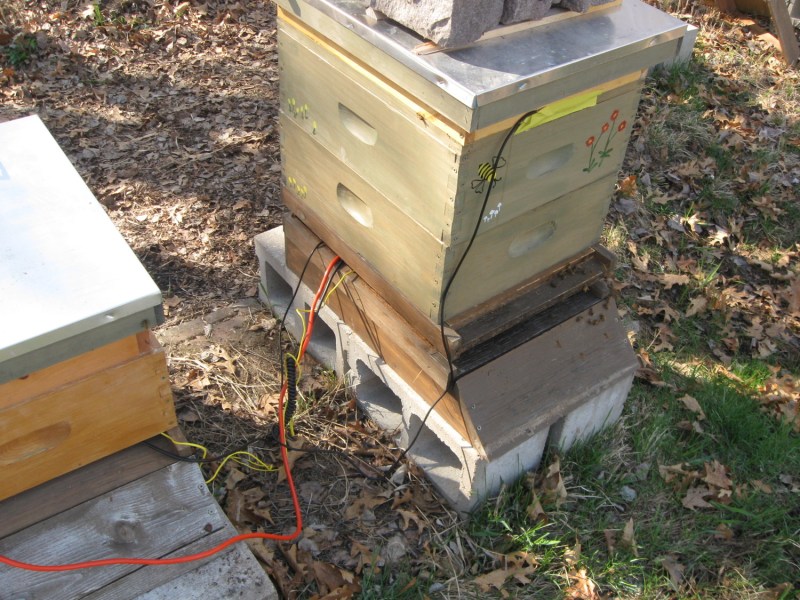[Ken] keeps his bees remotely and can’t check on them as often as he might like to. He wanted some way of knowing when they were out of space, because that slows down their nectar collection. He knew he could do this by remotely tracking the weight and internal temperature of the hives.
His first prototype revolved around a postal scale that couldn’t be turned off between readings. This meant that he needed a bigger solar panel and battery than originally intended. For about a week, the hives were sending data to Thingspeak through an Arduino Fio over XBee.
The current iteration measures the load cells with an HX711 24-bit ADC. This sends the scale data to an Apitronics Bee unit, which adds in temperature data from the hives and sends everything to an Apitronics Hive. [Ken] will also stream it to a cloud service so he can monitor them in real-time. [Ken] wants to see as much data as possible and contribute to NASA’s HoneyBeeNet program, so he has a second Bee unit set up to handle a nearby Apitronics weather station.
 The project featured in this post is a semifinalist in The Hackaday Prize.
The project featured in this post is a semifinalist in The Hackaday Prize.
















Sweet! It would be cool to have a counting device tracking the number of worker bees coming in vs leaving, then see how that signal correlates with changes in hive weight.
Aside from the acronym, here’s a university site collecting live data and streaming video from several hives: http://www.hobos.de/en/teachers-pupils/hobos-data/basics.html
I’m a beekeeper too but I don’t eat honey. Too often I found my bees enjoying a dog poop or *water* from my cesspool. No way I’d anything produced by them.
>No way I’d anything produced by them.
Sorry, a typo. I meant: No way I’d eat anything produced by them.
let me guess,
you have one type of seasonal flower planted for your hives….
Better not eat beef then. Because it may come from one of the steers I have seen standing in the feedlot lagoon drinking the *water* :)
I would think that dog poop has some sort of nutritional value. Fiber anyhow.
Have you considered the full process, of how Honey bees collect Nectar and Pollens from flowers, store them in their Crop chamber. It is converted into Honey (by the action of digestive enzymes), which is then vomited out and stored in the Honeycomb of the Hive.
That certainly would explain the smell of honey.
Best avoid pork products. And chicken. never, ever, ever, consume chicken. And have you seen the $h17 they use to grow vegetables with? Heck, you do know that fish eat, screw, and crap in water, right? So best not to eat *or* drink anything. I hate to break it to you but most smells are made up of microscopic particles of the substance they came from, so if I were you I’d immediately break all ties with any of your friends who fart. Oh, (in my best Columbo voice) and one more thing, vehicle exhaust is found in the air all around you… no sense getting that in your eyes. You really need to go find a cave and seal yourself inside forever… just be sure to pick a cave without any dust or mold or guano.
tl;dr “Cease. Immediately. It’s for your own protection.”
this raw experience is already been developed.. in the latest Italian International Bee Fair I’ve personally seen 2 stands with 2 different proj about beehive monitoring. One of those was also able to count bees while they leave the hive.
The main scope of those machinery is to prevent a collapse or swarm.
Here’s another similar beehive monitoring project using a Spark.io (a neat web enabled ARM microcontroller that uses Arduino code).
Link for the above!
https://community.spark.io/t/beehive-monitor-udp-sleep-thermistor-wifi-antenna-adc-speed-ram/4524
Thanks a lot, that’s one I haven’t seen before! Most other projects are restricted to using mains power, so something like this that focuses on low power operation is something I could definitely learn from!
I’ve also spent most of my time working on a low-cost, accurate scale. While they can certainly be purchased for $160+, I should be able to build something for closer to $50 — a huge difference when you want to monitor more than one or two hives!